Many times, we hear that the Church needs to be more credible and that if the world does not believe, it is because the Church is not credible enough. It is precisely from this conviction that the meeting of the General Secretaries of the European Bishops’ Conferences began. Two days of online meetings brought together 48 participants connected from their respective headquarters, to reflect together on the “Authenticity of the Church and Credibility in Her Mission starting from the Encyclical Ecclesiam Suam”.
After the welcome of the participants and the introduction of the work by Fr Martin Michalíček, CCEE General Secretary, Msgr Ivo Tomašević, General Secretary of the Bishops’ Conference of Bosnia and Herzegovina, gave the first presentation entitled “Authenticity of the Church in ad intra relations”.
It was a wise reading on the side of dialogue ‘ad intra’, and in the light of Ecclesiam Suam, by the most senior of the General Secretaries thanks to his seventeen years in this service for the Bishops’ Conference of Bosnia and Herzegovina, who also shared with the participants some reflections on his presence at the many meetings organised by CCEE: “I had the opportunity, as secretary of a small Bishops’ Conference, to visit most of the European countries and to get to know the life of the Church within them… I could define these meetings as a true intra-ecclesial dialogue. They have helped me to know and love the Catholic Church and my mission in it even more.”.
If it is true that it is the holiness of the Church that makes us holy, just as it is the faith of the Church that makes us believers, and not vice versa, this also applies to its credibility: the Church is authentic and true by its very nature and institution. But when we talk about the credibility of the Church, we look at the credibility of the men and women of the Church. It is precisely their behaviour that makes the Church more, or less, credible.
Saint Paul VI, in point 41 of Evangelii Nuntiandi writes: “Modern man listens more willingly to witnesses than to teachers, and if he does listen to teachers, it is because they are witnesses… It is therefore primarily by her conduct and by her life that the Church will evangelize the world, in other words, by her living witness of fidelity to the Lord Jesus- the witness of poverty and detachment, of freedom in the face of the powers of this world, in short, the witness of sanctity”.
The Church, an immense gift of Christ’s love, born from his side on the cross, must rediscover its call to holiness, continued Fr Ivo: “A sure sign that I love the Church is that I do my best to walk in the way of Jesus Christ, that is, in the way of holiness. The saints, throughout history, have been a priceless gift to the Church. The saints are the realisation of the Church in daily life and the most beautiful face of the Church in the world”.
Now, since it is the actions of the men of the Church that make them scarcely credible and consequently, with them, also make the Church scarcely credible, it is necessary to “a continual process of self-examination and re-appraisal of its external conduct…all conversion begins on the knees”.
It is necessary to have a sense of Church that: “The pastor has no right in the name of democracy or alleged humility to shirk his task, because it has been entrusted to him by the Church in the name of Christ”. And he concluded: “The Church is sent to proclaim the Kingdom of God and to proclaim the Gospel of Christ using all good ways in the time in which She lives, but never to renounce Her mission… never to renounce Her mission”.
Finally, quoting Pope Paul VI, he hoped that the discourse within the Church would be a “frequent occurrence and on an intimate level. May it be open and responsive to all truth, every virtue, every spiritual value that goes to make us the heritage of Christian teaching. We want it to be sincere. We want it to be an inspiration to genuine holiness. We want it to show itself ready to listen to the variety of views which are expressed in the world today. We want it to be the sort of dialogue that will make Catholics virtuous, wise, unfettered, fair-minded and strong” (ES no. 113).
The second part of the meeting was dedicated to dialogue ‘ad extra’ and to the credibility of the Church in its relationship with society, with an interesting talk given by the Irish journalist David Quinn, director of IONA, Institute for Religion and Society, columnist for the Sunday Times (Irish Edition) and for The Irish Catholic.
In his analysis of how the Catholic Church is regarded within Europe, Quinn started from this current time of pandemic and the fact that “we faced an unprecedented situation almost everywhere in Europe. We were prevented from holding public worship”. During the first lockdown, almost all governments prevented church celebrations and then, some before others, allowed them again. In some countries it took court cases. In others, it took direct intervention by the bishops. This issue has “provided something of a litmus test for how well regarded and respected Churches are in society. It has also been a litmus test for how we balance freedom versus safety. It has been a litmus test for the Churches themselves. How do we balance freedom of worship against safety? In some countries, Churches have simply listened to public health experts without resistance, without asking for evidence showing it is necessary to totally stop public worship.
In other countries, Churches have been quicker to stand up to public health experts and Governments and make a strong case for restarting public worship. Some of this comes down to self-confidence and how we think we are viewed by society”.
Another sensitive issue where we see the same thing, Quinn continued, is education and Catholic schools. “Pope Paul VI wondered in Ecclesiam Suam about the place of the Church in society. The place of faith schools in society is a sort of proxy for this. Does the State respect and recognise the right of faith schools to exist? Will it give them public funding? Have they freedom to teach what they want to teach? Are they forced to teach things they don’t want to teach? Can they maintain their identity when many pupils and parents belong to different faiths and none?”. And he added, “it is up to the Church to defend its own autonomy and that of the civil society and fight with families for recognition of their right to be the primary educators of their children”.
Finally, he addressed the role of the media in shaping the vision of the Church for the general public. “Negative portrayals of Christians are commonplace, When I go on programmes, I am sometimes treated as a curious anthropological specimen”. He then added: “There is no easy way to solve this, but if we want dialogue with the world, it must include dialogue with journalists.
It also means building personal relationships with journalists, building relationships based on trust. It also means having plenty of people willing and able to go on programmes, especially when this involves contentious issues. Otherwise, it will be assumed our positions are simply indefensible”.
He concluded: “Do we believe we have something to contribute that is unique and uniquely special? Perhaps we first have to re-evangelise the Church, before we can attempt to re-evangelise the world. The world needs a renewed Church, because the world, starting with our own home here in Europe, also needs renewal. This starts and finishes in Christ. This remains our mission and our message”.
Each General Secretary, during the meeting, had the opportunity to present the most significant initiatives taken by their individual Bishops’ Conference in the recent period and to discuss the challenges that are being faced at the present time. In addition to these interventions, there were reports from the Secretaries of the Commissions who presented the activities and upcoming commitments of the CCEE Commissions and Sections.

